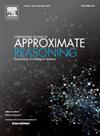基于证据冲突的大视觉语言模型中的视幻觉检测
IF 3
3区 计算机科学
Q2 COMPUTER SCIENCE, ARTIFICIAL INTELLIGENCE
引用次数: 0
摘要
尽管大型视觉语言模型(LVLMs)具有显著的多模态能力,但视觉输入和文本输出之间经常出现差异——我们将这种现象称为视觉幻觉。这种关键的可靠性差距对安全关键型人工智能(AI)应用构成了重大风险,需要全面的评估基准和有效的检测方法。首先,我们观察到现有的以视觉为中心的幻觉基准主要是从感知角度评估lvlm,忽略了由更高级的推理能力产生的幻觉。我们开发了感知-推理评估幻觉(PRE-HAL)数据集,该数据集能够跨多个视觉语义(如实例,场景和关系)系统地评估lvlm的感知和推理能力。使用这个新基准进行综合评估暴露了更多的视觉漏洞,特别是在更具挑战性的关系推理任务中。为了解决这一问题,据我们所知,我们提出了第一个基于Dempster-Shafer理论(DST)的基于不确定性估计的LVLMs视幻觉检测方法。该方法的目的是在模型推理阶段有效地捕获高级特征的冲突程度。具体来说,我们的方法采用简单的质量函数来减轻幂集上证据组合的计算复杂性。我们使用新的PRE-HAL基准对最先进的LVLMs、llva -v1.5、mPLUG-Owl2和mPLUG-Owl3进行了广泛的评估。实验结果表明,我们的方法优于5个基线不确定度度量,在3个LVLMs中平均AUROC提高了4%和10%。值得注意的是,它在场景感知任务中表现出显著的鲁棒性。这些结果验证了特征级冲突分析为增强LVLM可信度提供了一种可扩展的、经济有效的解决方案。我们的代码可在https://github.com/HT86159/Evidential-Conflict上获得。本文章由计算机程序翻译,如有差异,请以英文原文为准。
Visual hallucination detection in large vision-language models via evidential conflict
Despite the remarkable multimodal capabilities of Large Vision-Language Models (LVLMs), discrepancies often occur between visual inputs and textual outputs—a phenomenon we term visual hallucination. This critical reliability gap poses substantial risks in safety-critical Artificial Intelligence (AI) applications, necessitating a comprehensive evaluation benchmark and effective detection methods. Firstly, we observe that existing visual-centric hallucination benchmarks mainly assess LVLMs from a perception perspective, overlooking hallucinations arising from more advanced reasoning capabilities. We develop the Perception-Reasoning Evaluation Hallucination (PRE-HAL) dataset, which enables the systematic evaluation of both perception and reasoning capabilities of LVLMs across multiple visual semantics, such as instances, scenes, and relations. Comprehensive evaluation with this new benchmark exposed more visual vulnerabilities, particularly in the more challenging task of relation reasoning. To address this issue, we propose, to the best of our knowledge, the first Dempster-Shafer theory (DST)-based visual hallucination detection method for LVLMs through uncertainty estimation. This method aims to efficiently capture the degree of conflict in high-level features at the model inference phase. Specifically, our approach employs simple mass functions to mitigate the computational complexity of evidence combination on power sets. We conduct an extensive evaluation of state-of-the-art LVLMs, LLaVA-v1.5, mPLUG-Owl2, and mPLUG-Owl3, with the new PRE-HAL benchmark. Experimental results indicate that our method outperforms five baseline uncertainty metrics, achieving average AUROC improvements of 4% and 10% across three LVLMs. Notably, it exhibits remarkable robustness in scene perception tasks. These results validate that feature-level conflict analysis offers a scalable, cost-effective solution for enhancing LVLM trustworthiness. Our code is available at https://github.com/HT86159/Evidential-Conflict.
求助全文
通过发布文献求助,成功后即可免费获取论文全文。
去求助
来源期刊

International Journal of Approximate Reasoning
工程技术-计算机:人工智能
CiteScore
6.90
自引率
12.80%
发文量
170
审稿时长
67 days
期刊介绍:
The International Journal of Approximate Reasoning is intended to serve as a forum for the treatment of imprecision and uncertainty in Artificial and Computational Intelligence, covering both the foundations of uncertainty theories, and the design of intelligent systems for scientific and engineering applications. It publishes high-quality research papers describing theoretical developments or innovative applications, as well as review articles on topics of general interest.
Relevant topics include, but are not limited to, probabilistic reasoning and Bayesian networks, imprecise probabilities, random sets, belief functions (Dempster-Shafer theory), possibility theory, fuzzy sets, rough sets, decision theory, non-additive measures and integrals, qualitative reasoning about uncertainty, comparative probability orderings, game-theoretic probability, default reasoning, nonstandard logics, argumentation systems, inconsistency tolerant reasoning, elicitation techniques, philosophical foundations and psychological models of uncertain reasoning.
Domains of application for uncertain reasoning systems include risk analysis and assessment, information retrieval and database design, information fusion, machine learning, data and web mining, computer vision, image and signal processing, intelligent data analysis, statistics, multi-agent systems, etc.
 求助内容:
求助内容: 应助结果提醒方式:
应助结果提醒方式:


